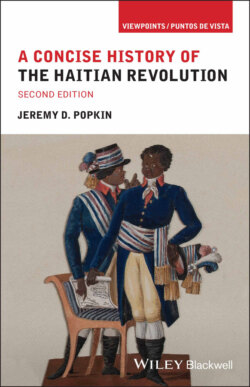Читать книгу A Concise History of the Haitian Revolution - Jeremy D. Popkin - Страница 15
The Culture of the Black Population
ОглавлениеForced to live under the harsh discipline of their masters, the enslaved blacks in Saint-Domingue nevertheless managed to develop some communal life and to find ways to oppose the worst forms of oppression. Although captives from different plantations were not supposed to mix, masters, knowing that a few concessions made them less likely to revolt against their situation, looked the other way when they gathered for meetings and dances on their weekly days off. When black captives came together they would often hold religious ceremonies that combined African rituals and elements of the Christian practices with which some of them had come into contact. Out of this fusion of elements there emerged in the course of the eighteenth century a distinctive religion, vodou, in which worshipers went into trances in which they were seized by the spirits of various African spirits or lwa, whom the blacks often identified with particular Catholic saints. Vodou ceremonies helped unify an enslaved population drawn from many different African ethnic groups. Individual enslaved blacks were sometimes able to build up a small pécule of personal savings by selling part of the crops they raised in their private food plots or by persuading their masters to let them hire themselves out; in certain cases, individuals were able to purchase their own freedom with these earnings.
The prerevolutionary life of the future Toussaint Louverture, then known as Toussaint Bréda because he lived on the Bréda plantation, is an example of the way in which one exceptional individual born into slavery in Saint-Domingue was able to gain free status during the colonial era. Claims that Louverture was descended from a West African king are probably unfounded, but stories passed down in his family that his intelligence, his determination, and his ability to work with animals distinguished him even as a youth are more plausible. He managed to learn to speak and read French; analysis of his largely phonetic spelling suggests that he acquired the accent of the colonists from southwestern France who were numerous in the colony. He became a devout Catholic and remained loyal to that religion throughout his life, although, like many blacks, he may also have practiced vodou. Even before he gained his own freedom, he formed a first marriage with a free woman of color, an unusual opportunity for an enslaved man. He became the coachman for the manager of the Bréda plantation on which he lived, and it was probably through this connection that he obtained his legal freedom in the 1770s. After his emancipation, he briefly owned a small plantation with several enslaved laborers, but this venture does not seem to have succeeded and he returned to work on the Bréda population, where his second wife Suzanne and several other relatives were among the enslaved population. Unlike enslaved blacks, Louverture was able to move around freely, which gave him the opportunity to build up a network of friends and contacts, many of whom would be useful to him when he emerged as a leader of the Haitian Revolution.5
Very few enslaved blacks were able to escape the limits imposed on them in colonial Saint-Domingue, but whenever they could, they expressed their opposition to their treatment through various forms of individual and collective resistance. What masters saw as the blacks’ inherent laziness was undoubtedly a deliberate response to a system in which they were denied any benefits from their labor. Rather than bear children who would grow up under slavery, women used plants and herbs to induce abortions; like most enslaved populations in the Americas, the captive workforce in Saint-Domingue required constant importations from Africa to maintain its numbers. Marronnage or escape from the plantations was another common form of resistance. In some cases, it was a way for blacks to protest against a particularly cruel overseer or commandeur, and runaways might negotiate their return to the plantation in exchange for a promise of better treatment. Some groups of marrons succeeded in fleeing into the mountains and established independent bands; one group in a remote area along the border with Spanish Santo Domingo maintained itself for nearly a century, although its numbers were relatively small. Runaways could also take refuge in the colony’s cities, where they might be able to pass themselves off as freedmen and make a living as day laborers.
Although they normally claimed that they could easily manage their enslaved workforces, masters lived in fear that the blacks might turn against them. Plantation-owners blamed any unexplained illnesses or deaths among their captives or their livestock on poisoning, which the colony’s whites claimed was the blacks’ main weapon. In 1757–8, the entire colony was swept by fear of a conspiracy, supposedly organized by an enslaved black man named Makandal, to poison all the whites and take over the island. The deaths attributed to Makandal were all among enslaved blacks, and it is not clear that they were due to poison rather than to disease, but he was tortured and burned alive in Cap Français in 1758. According to legend, he turned himself into a fly and escaped from his executioners. Even today, Makandal’s name is remembered in Haiti as a symbol of resistance to oppression. Despite the whites’ fears, overt collective resistance to the slavery system was rare: unlike the neighboring British island of Jamaica or the Dutch mainland colony of Surinam, for example, Saint-Domingue experienced no major slave revolts in the decades prior to 1791. This was certainly not because the blacks found their situation acceptable, but until 1791 they did not see any realistic prospect of changing it through collective violence.
